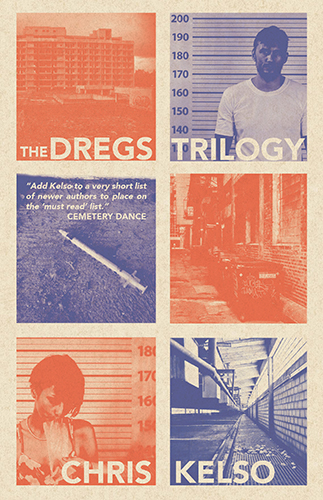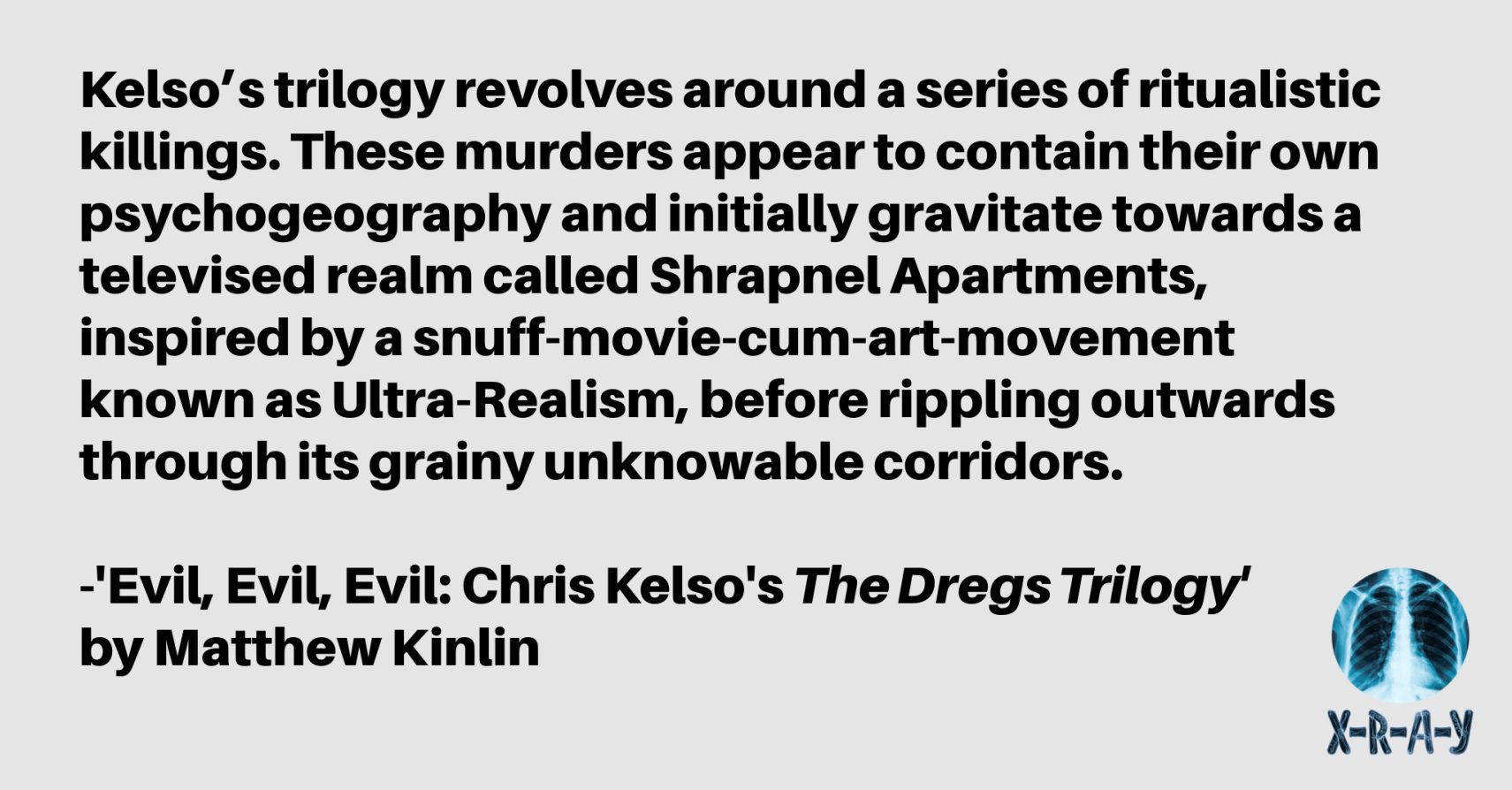“They say you can hide from Blackcap if you burn all your dreams.”
– Alfie McPherson, Ritual America
 Chris Kelso’s The Dregs Trilogy (Black Shuck Books, 2020) is a triptych of novellas: Shrapnel Apartments, Unger House Radicals, Ritual America; where each part deepens and troubles its sibling. The book moves backwards and forwards through time and space, from the Ituri Forest in the Democratic Republic of Congo to a backwoods area near Winnipeg, to Louisiana and a number of other locations; some terrestrial, others interdimensional. Kelso’s trilogy revolves around a series of ritualistic killings. These murders appear to contain their own psychogeography and initially gravitate towards a televised realm called Shrapnel Apartments, inspired by a snuff-movie-cum-art-movement known as Ultra-Realism, before rippling outwards through its grainy unknowable corridors. The victims of these murders are given a voice and often describe their own execution in direct, deadpan fashion. The central victim that is returned to is a young girl called Florence Coffey. Her suffering is recurring and endless. The bodies of these ritualistic killings are delivered to an entity that links the many strands and subplots of the book. The name of this entity is Blackcap. Assisted by another being known as King Misery, their multitudinous appetites flow and feed upon human consciousness.
Chris Kelso’s The Dregs Trilogy (Black Shuck Books, 2020) is a triptych of novellas: Shrapnel Apartments, Unger House Radicals, Ritual America; where each part deepens and troubles its sibling. The book moves backwards and forwards through time and space, from the Ituri Forest in the Democratic Republic of Congo to a backwoods area near Winnipeg, to Louisiana and a number of other locations; some terrestrial, others interdimensional. Kelso’s trilogy revolves around a series of ritualistic killings. These murders appear to contain their own psychogeography and initially gravitate towards a televised realm called Shrapnel Apartments, inspired by a snuff-movie-cum-art-movement known as Ultra-Realism, before rippling outwards through its grainy unknowable corridors. The victims of these murders are given a voice and often describe their own execution in direct, deadpan fashion. The central victim that is returned to is a young girl called Florence Coffey. Her suffering is recurring and endless. The bodies of these ritualistic killings are delivered to an entity that links the many strands and subplots of the book. The name of this entity is Blackcap. Assisted by another being known as King Misery, their multitudinous appetites flow and feed upon human consciousness.
Kelso’s trilogy evokes a watercolour painting called Hands of Fire from American artist, hospital janitor and recluse, Henry Darger, which shows a group of young girls waking from their beds at night. Frightened, they look up as two enormous orange hands descend from the ceiling. Darger’s mythical world-view presents his children of Abbieannia, or the Vivian Girls, fighting against evil Glandelinian overlords, but the hopeful youths are often slain in battle or brutally tortured. Darger is mentioned once in Kelso’s trilogy, in the central novella Unger House Radicals. This story revolves around a young filmmaker Vincent Bittacker who, after falling in love with a serial killer called Brandon Swarthy, moves into the Louisiana house of child murderer Otto Spengler. Unger House becomes a neo-Nazi fort for their burgeoning homosexual relationship and exploration of the artistic practice known as Ultra-Realism: the act of committing murder on film, cinéma vérité taken to its furthest limits. Their initiation into Ultra-Realism involves the killing of a girl known as Janice. Kelso later writes, “The Glandelinian race sought inspiration from Darger’s text and set out to be the scourge of Abbieannia.” Here we have an inversion of Darger’s myth where the radicals of Unger House identify with the monstrous Glandelinian race. Bittacker and Swarthy devour a thousand sources and realign them to intensify their brutality and fascism, extermination dressed up as avant garde.
After the murder of Janice, “The sky has a milky hue. Vince realises that he can no longer appreciate the beauty in anything except violence…” He then compares the image of Janice’s half-dissected body with Andy Warhol’s five-hour film Sleep. Warhol is filming his lover John Giorno, “We can see up his nostrils, see the triangular mound of philtrum and septum.” Like a fly crawling across a corpse, the image on the screen offers both a source of voyeuristic pleasure and physical revulsion. Bittacker responds with, “I hate this movie. I hate all Warhol’s movies. Why do I do this to myself?” Why do these men commit unspeakable acts? There’s an ambiguity to their Glandelinian philosophy. As Sartre writes of Genet, his thugs invent an artistry to their savagery: “The criminal dances his crime as the ballerina dances the dagger step.” At first, Bittacker and Swarthy seem to delight in the irony of their position: their so-called Ultra-Realism is deeply performative. They even go on to pronounce, “We wanted to make Unger House the new Grand Guignol.” Evil has become simply vaudeville, a ghostly cabaret of sexual pathology. As Sartre writes, “It is Evil which is a ballet. We now see the matter more clearly: if the world of Evil is only a play of appearances and conventions, it depends on the consciousness of the spectator who contemplates it.” Bittacker and Swarthy have invented an audience for their Nazi snuff pantomime but it soon implodes into jealousy, paranoia and mental collapse.
Throughout The Dregs Trilogy, its many killers feed on the mythology of Otto Spengler and a white power, misogynistic band known as King Misery, named after a murderous and malevolent being. However, their voraciousness finds its apex in the cosmic entity of hyperstition called Blackcap. Who is Blackcap? Blackcap is no one and everywhere. Dr Wilson describes him as: “A nocturnal, bat-winged monster exiled to the stars. Appearing as a gelatinous mass extruding razored tentacles to some, and as an itinerant showman to others.” Dr Baker offers, “He looks sort of like a jellyfish. Three-lobed burning eye all flared.” Blackcap weaves his way through all three sections of the book. There is no escape. One of his victims, Lydia Pittmann, explains, “I soon came to realise that if you reject the philosophy of Blackcap and his gang then you wind up here. In the demi-plane.” Orange hands descending from the ceiling. Blackcap is interdimensional and swims through the nightmares of all his accomplices and victims. In Male Fantasies 2: Psychoanalysing the White Terror, Klaus Theweleit writes that the fascist male sees the general population as hybrid, unclean and often animal: “It has a thousand legs, a thousand heads, it can generate a thousand degrees of heat. It can metamorphose into a single creature, many-limbed: rat, snake, dragon.” Blackcap is like an octopus inside the brain. Its fluid nature is feminine and multiple, or as Theweleit conceives, “the belly of the erotic woman menstruating or ‘ruptured’ in childbirth: the Hydra, the head of the Medusa, the Gorgon.” Theweleit argues the fascist male’s central fear is one of disintegration so, “his role is the builder of dams, as killer, exterminator.” Is Blackcap an alien entity from outer space or an unconscious projection? Murderer Beau Carson tells us, “Blackcap doesn’t come from the sky, or the woods for that matter. He comes from somewhere else, down there. In the aquatic arena of the gods.”
Lydia Pittmann is one of Blackcap’s many victims from Amber Acre and taken to a place known as Shrapnel Apartments, overseen by homicidal landlords. Prior to the suicide of William L. Bentley, we learn, “When I left for Shrapnel Apartments, I took Florence with me,” where, “I have a decent-sized fridge, two bathrooms, a shower and a WC. My apartment had direct access to the balcony and a view of the abyss and surrounding blackness.” Throughout the whole of The Dregs Trilogy, Florence Coffey is the victim obsessively returned to again and again. Similar to Laura Palmer from Twin Peaks, Florence’s body becomes a recurring site of interdimensional torture and abuse. Like one of Darger’s girls, she is running amongst the Glandelinians and Blengigomeneans: gigantic winged beings that can take part-human form. A disturbing feature of Kelso’s work is the inclusion of autopsy reports, similar in style to Warhol’s clinical filming of his dreaming subjects. A report states, “Ms. Florence Coffey was a 13-year-old white female who was reportedly found by law enforcement in a bathtub and unresponsive.” We then learn, “Her arms, a portion of sternum, heart, and left lobe of liver were found wrapped in a plastic bag in a laundry basket.” What makes these episodes even more disorientating is that we also hear from the victims during their own autopsies. Florence explains, “Everything you’ve heard about autopsy dreams are true. And the roughness of the doctor working on you.” The thousand-year-old Tibetan text Bardo Thödol, translated as Liberation Through Hearing During the Intermediate State, states that after death the human soul occupies an intermediate space between death and rebirth. Following her brutal killing and dismemberment, Florence floats in limbo in the post-mortem state of Bardo. Her suffering is multiplied and glorified in the hearts of Blackcap’s followers, ad infinitum.
Dr Baker explains further the endless appetites of Blackcap, devouring, “children, unmarried women and people who have died of leprosy or snake bites… These people are set afloat down the Ganges, where the tribesman from the Aghori Babas retrieve their corpses and ritually consume them. This is Ritual America and our sacraments can be equally barbaric.” We have the meeting of barbarism with the holy. Atrocity serves a higher god that resides inversely in the bowels. In Totem and Taboo, Freud writes, “The holy mystery of sacrificial death is justified by the consideration that only in this way can the sacred cement be procured which creates or keeps alive a living bond of union between the worshippers and their god.” They are cleansed and connected to Blackcap in their consumption. Florence Coffey is the totemic animal of Blackcap that must be ritualistically slaughtered and eaten again and again to reinforce their fascist hygiene and their holy bond. They are so clean in her blood and sorrow. They feel much stronger. As William Blake, a visionary that complements Darger’s dichotomous worldview, writes, “Evil is the active springing from Energy.” The madmen of The Dregs feed and renew themselves on Vivian Girls but this energy soon fades away, the spilling blood of Florence is short-lived. Bataille writes that the goal of Sade was, “enumerating to the point of exhaustion the possibilities of destroying human beings, of destroying them and enjoying the thought of their death and suffering.” The energy of Evil soon gives way to boredom. Bittacker glamorises his sadism with Aryan mysticism but it quickly falls into childish games of delusion and misery. A Darger painting of a horned red dragon looming over a pile of dead children. As one character drily remarks, “People always feel the need to conjure up these ugly spirits as a way of rationalising the bad things that happen in the world and the awful things human beings do to each other.”

